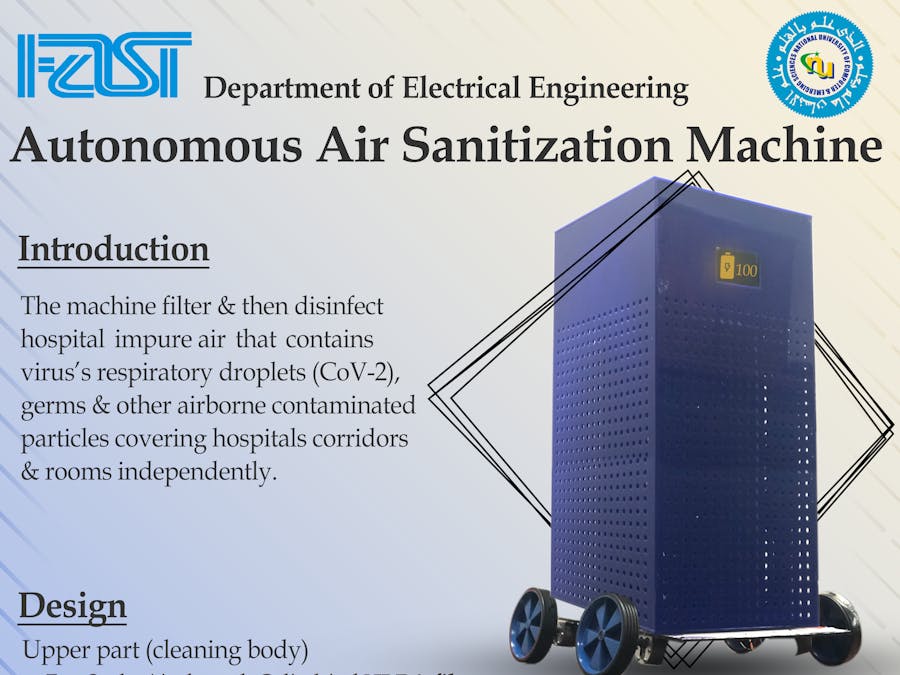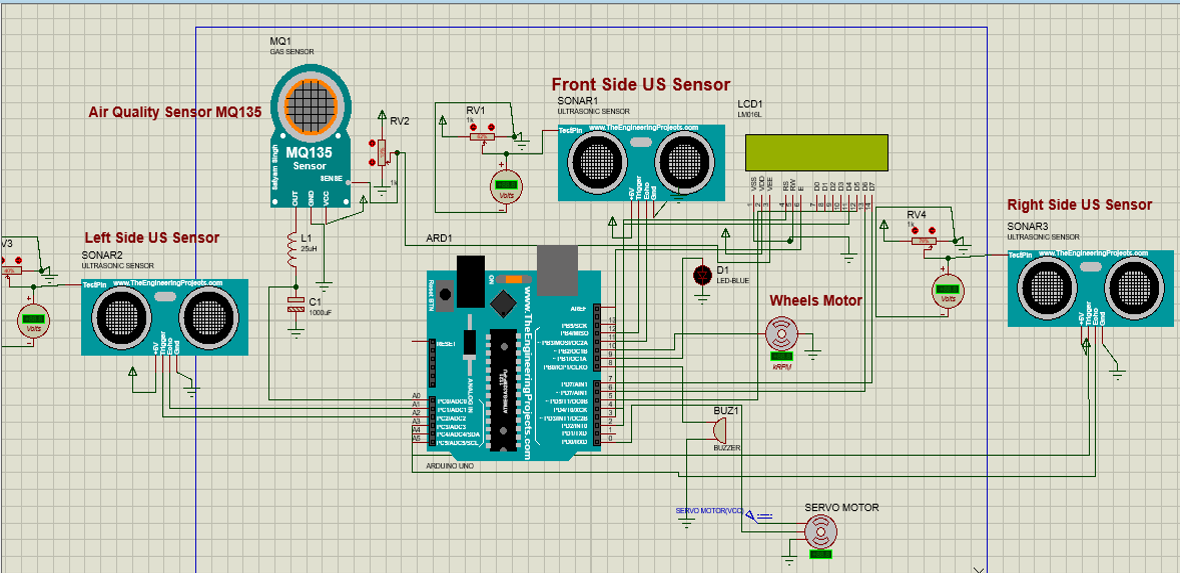Autonomous Air Sanitization Machine is an autonomous body for filtering and killing germs present in air specifically COVID particles. The COVID-19 outbreak and its rapid spread in the year 2019 and onwards the world faced 269 million cases till date and almost 5.3 million deaths. The purpose of the project is to design and implement an Autonomous Air Sanitization Machine that would be capable to disinfect air. The machine will firstly filter the air, then kill the germs and provide clean air. This is primarily intended for hospital environments that are surrounded by infectious air. A map will be traced earlier in the area by the machine and saved, this machine will move autonomously on the mapped region and accomplish its task. Obstacle Sensing along the path is done by 4 Ultrasonic Sensors anchored at each side of the autonomous body. On detection of a human body, buzzer will ring to give him a signal to move sideways. The machine will eliminate 90% of smoke, dust, viruses, germs, COVID-19 and other particles as small as 0.1 microns. Machine will take 8.5 minutes to disinfect a 600 square foot area. The proposed project is autonomous, cost-effective and reduce the risk of COVID spread specially in hospitals.
IntroductionThe COVID-19 outbreak and its rapid spread in the year 2019 and onwards the world faced 269 million cases till date and almost 5.3 million deaths. Pakistan handled 1.29 million cases and endurance 28.863 thousand deaths. COVID transmits when people breathe in air contaminated by droplets and small airborne particles containing the virus. The risk of breathing these droplets in is highest, when people are in close proximity. Air pollution not only affects the air we breathe outside, in fact the air inside our house or workplace may be two to five times more contaminated. Because we spend 90% of our time indoors, even low amounts of indoor air pollution can have a harmful impact on our health. This emphasizes the need to maintain the highest possible indoor air quality.
The purpose of the project is to design and implement an Autonomous Air Sanitization Machine that would be capable to disinfect air. The machine will filter the air and then kill the germs and provide clean air. This is primarily intended for hospital environments that are surrounded by infectious air. A map will be traced early in the area by the machine and saved, this machine will move autonomously on the mapped region and accomplish its task. If the machine is to be moved to a different location, the map can be restored.
This report will strive to review the client’s requirements and the preliminary design of the product. Furthermore, it will shed light on the problem analysis, the desired product specifications, simulations, actual implementation and testing. There are a number of chapters in this report each explaining the different parts of the project. Chapter 2 presents the problem definition in the context of a complex engineering problem which requires knowledge of multiple domains and involves complex engineering activities for its solution. Chapter 3 comprises of problem analysis where a scientific analysis of the complex engineering problem has been carried out. Any projects that resemble this project are listed followed by the distinguishing features of this project. Moreover, the societal and environmental implications of this project are also listed in this chapter. The next chapter, chapter 4, describes in detail the design and implementation work done on the project. This section describes the hardware and the software design of the product. Chapter 5 provides the details of the testing carried out and the results obtained. Chapter 6 presents a user guide to make sure the customers face no problems while using the product. The deliverables and costs are mentioned in Chapter 6 which explains the project plan and the projected costs. The last chapter, chapter 8 concludes the project report by briefly stating the achievements of the project while comparing to the objectives that were set and stating any further work that can be done.
Problem FormulationThe air inside hospital could be unaccountably toxic, leading to dust allergies, breathing issues and asthma specially leaving kids vulnerable. The COVID-19 increment & its various variants lead to feeble health or death. Wearing masks and sanitizing our hands and the goods around us is for sure necessary, but what if the air in which we breathe, either inside or outside is contaminated. Sanitizing is very necessary nowadays and everyone wants a clean and sanitized environment, especially in hospitals where large numbers of COVID patients are admitted and breathe in the same ward/area, which is unsafe. Due to infected air, hospital visitor could be prey to COVID-19. Following is the graph of COVID-19 rise in Pakistan.
Engineering Problem ModelProject Objective is to decrease the risk of spreading viruses such as COVID 19 in hospitals and other areas. Our prototype consists of two processes:
Filtration
Disinfection
FiltrationThe filtration process will firstly filter out large particles of 20 microns in size such as dust mite waste particles and pollen grains. Secondly, the main filter will filter out particles of size larger than 0.1 microns which includes COVID and other viruses. This process will detain all contaminated particles within the filter.
DisinfectionFor the disinfection process, UV light rays will kill the contaminated particles accumulated in the filter. UV light rays will only expose to filter, so that rays may not produce any harmful effect on humans.
Preliminary Product SpecificationFollowing are basic product specifications list:
1. Eliminate 90% of smoke, dust, viruses, germs, COVID-19 and other particles as small as 0.1 microns.
2. Display air quality, charging and distance covered.
3. Disinfect average hospital room of 600 square feet in 8 minutes.
4. Filter life 5 to 7 months.
5. Max noise level needs to be less than or equal to an air conditioning window unit.
6. Net weight 9 kg approx.
7. Dimensions 300 * 300 * 700 mm.
8. DC Voltage 12 V.
9. Incline a slope of 25 degrees.
10. Smooth operation with rubber wheels.
Recent Similar ProjectsVirus-Killing Air Filtration System (By Cambridge Scientists and Engineers)A new carbon-based air filtration nanomaterial capable of capturing and destroying various viruses, including animal coronavirus, a close relative of SARS-CoV-2, the virus that causes COVID-19 has been developed by Cambridge scientists and engineers.
Curbing air pollution with purification towers (By University of Minnesota)The air in Delhi, India is thick with smog, ridden with fine particles of sulfates, nitrates, and carbon that millions of residents inhale every day. Imagine a nearly 60-foot tall tower, equipped with a state-of-the-art filtration system, sucking in these particles and pushing out clean, breathable air.
City Air Purification System (By Arup and Sino Green) The sustainable arm of Hong Kong property developer Sino Group, developed a patent pending air purification system that targets street-canyon pollution at the pedestrian level. The prototype, which resembles a bus shelter, was tested at a busy intersection in Hong Kong, where pollution levels are double that of the World Health Organization’s recommended limits. Inside, a fan, a pre-filter, and a medical-grade HEPA bag filter circulate the air to remove both large and fine particles. A vent in the canopy directs the newly clean air down to waiting bus riders, where a pressurized air–barrier keeps unfiltered air away.
Societal and Environmental Implications of the ProjectDue to the COVID out break and its rapid spread in the year 2019 and onwards the world faced 269 Million cases till date and almost 5.3 Million deaths which is quite of a number. In this situation, although vaccine is there to stop rapid spread of COVID but still it is high time for hospitals to have a machine that can clean the infected air with different variants to at least have a safer surrounding for doctors, nurses, patients 24 hours a day.
The machine doesn’t eject any gas or material that may causes any societal, legal, cultural and environmental issues.
Machine can also produce good results, if used in large buildings.
Yielding a pure atmosphere, this machine could be a daily life partner as well.
Storing the Map1. Firstly, place the body from where you want to start (preferably near the charging point). Call it point ❶.
2. Switch ON the power button, start moving the body with the help of ↑, ↓, →, ← keys and STOP button on the remote.
3. Move it along all the areas you want it to cover autonomously. NOTE: Machine will cover places in same order as you will store in for the first time.
4. Cover the areas in such a way that machine reaches its starting point at the end and then charging point.
5. After one round, set the machine to charging if required.
How to use the machine1. Place the machine at point ❶.
2. Press the REPEAT button for it to start. The machine will start moving across the stored map. NOTE: If a body/obstacle comes in the path, buzzer will ring until it moves away.
3. On completing its first round, if the charging is low set it to charge
ConclusionAutonomous Air Sanitization Machine kills germs and COVID 19 particles that travel within air using filtration and disinfection process. The filtration and disinfection processes went smoothly as theoretically explained on internet. Initial calculations are based on reference values of component and hence project outcome is not exactly in line with assumptions. Machine is tested in tough situations to identify all loop holes and clear them. Machine’s LCD clearly indicates the air quality before and after the presence of machine within the room, which results in a COVID free and improved air quality. According to the various surveys, Autonomous Air Sanitization Machine is based on an innovative idea and will have good market sales if commercialized.
Some adults and children experience multisystem inflammatory syndrome after they have had COVID-19. If this machine is brought in hospitals as well as other buildings, people can work in a heathy work environment without the fear of getting infected.




_wzec989qrF.jpg?auto=compress%2Cformat&w=48&h=48&fit=fill&bg=ffffff)






















_3u05Tpwasz.png?auto=compress%2Cformat&w=40&h=40&fit=fillmax&bg=fff&dpr=2)
Comments
Please log in or sign up to comment.